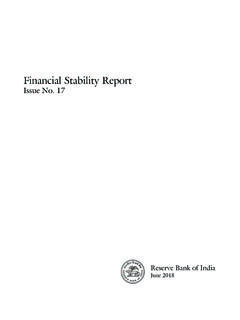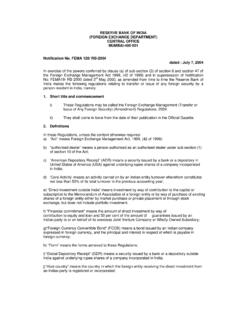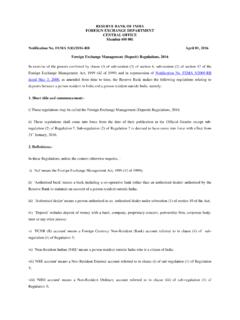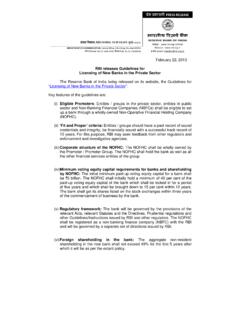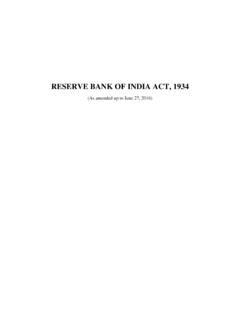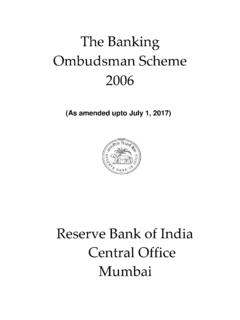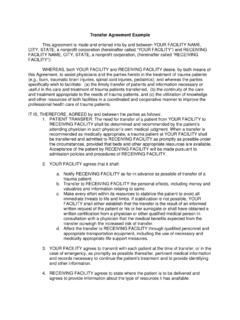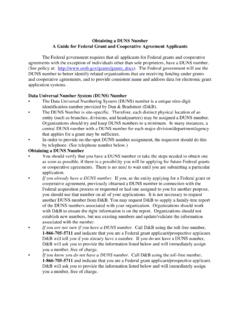Transcription of Comprehensive Cyber Security Framework for Primary (Urban ...
1 RBI/2019-20/129. December 31, 2019. To The Chairman/Managing Director/Chief Executive Officer All Primary (Urban) Co-operative Banks Madam/Dear Sir, Comprehensive Cyber Security Framework for Primary (Urban) cooperative Banks (UCBs) A Graded Approach Please refer to para I (3) of the Statement on Developmental and Regulatory policies of the Fifth Bi-monthly Monetary Policy Statement for 2019-20 dated December 5, 2019 (extract enclosed). 2. Please refer to our Circular dated October 19, 2018 wherein some basic Cyber Security controls for Primary (Urban) cooperative Banks (UCBs) were prescribed. On further examination, a Comprehensive Cyber Security Framework for UCBs has been formulated based on a graded approach. The UCBs have been categorised into four levels based on their digital depth and interconnectedness to the payment systems landscape.
2 The levels are defined as below: Level Criteria Regulatory Remarks Prescription Level I All UCBs Level I controls In addition to the controls prescribed in prescribed to the UCBs vide Annex I circular dated October 19, 2018, bank specific email domain with DMARC controls, two factor authentication for CBS etc., are salient controls prescribed. Level II All UCBs, which are sub-members of Level II controls Additional controls include Data Centralised Payment Systems 1 (CPS) given in Annex II, in Loss Prevention Strategy, Anti- and satisfying at least one of the criteria addition to Level I Phishing, VA/PT of critical given below: controls. applications. offers internet banking facility to its customers (either view or transaction based). provides Mobile Banking facility through application (Smart phone usage).
3 1 Ref: Master Direction dated January 17, 2017 on Master Directions on Access Criteria for Payment Systems . , , , - I, , , -400005. Department of Supervision, Central Office, World Trade Centre, Cuffe Parade, Colaba, Mumbai 400005. / Tele: +91 22 22189131-39; / Fax +91 22 22180157; /email : is a direct Member of CTS/IMPS/UPI. Level III UCBs having at least one of the criteria Level III controls Additional controls include given below: given in Annex III, Advanced Real-time Threat Direct members of CPS in addition to Level I Defence and Management, Risk having their own ATM Switch and II controls. based transaction monitoring 2. having SWIFT interface Level IV UCBs which are members/ sub- Level IV controls Additional controls include members of CPS and satisfy at least given in Annex IV, setting up of a Cyber Security one of the criteria given below: in addition to Level Operation Center (C-SOC).
4 Having their own ATM Switch and I, II and III controls (either on their own or through having SWIFT interface service providers), IT and IS. hosting data centre or providing Governance Framework software support to other banks on their own or through their wholly owned subsidiaries 3. The Board of Directors is ultimately responsible for the information Security of the UCB and shall play a proactive role in ensuring an effective IT(Information Technology) and IS. (Information Security ) governance. The major role of top management involves implementing the Board approved Cyber Security policy, establishing necessary organisational processes for Cyber Security and providing necessary resources for ensuring adequate Cyber Security . 4. UCBs shall undertake a self-assessment of the level in which they fit into, based on the criteria given in the table above and report the same to their respective RBI Regional Office, Department of Supervision within 45 days from the date of issuance of this circular.
5 5. All UCBs shall comply with the control requirements prescribed in Annex I within 3 months from the date of issuance of this circular. Similarly, Level II, III and IV UCBs are required to implement additional controls prescribed in Annex II, III and IV respectively. 6. UCBs may adopt higher level of Security measures based on their own assessment of risk and capabilities. Further, if a UCB, irrespective of its asset size already has a dedicated CISO. and/or governance Framework as discussed in Annex IV, then as a matter of best practice, it is desirable that it continues with the existing governance structure. 7. A copy of this circular may be placed before the Board of Directors in its ensuing meeting. 8. Please acknowledge receipt. Yours sincerely, (R. Ravikumar). Chief General Manager Encl: As above.
6 2. Risk Based Transaction Monitoring applicable only to those banks as discussed in Annex III of the circular Extract from the fifth Bi-monthly Monetary Policy Statement, 2019-20 announced on December 05, 2019. 3. Comprehensive Cyber Security Framework for Primary (Urban) cooperative Banks (UCBs) A Graded Approach The Reserve Bank had prescribed a set of baseline Cyber Security controls for Primary (Urban). cooperative banks (UCBs) in October 2018. On further examination, it has been decided to prescribe a Comprehensive Cyber Security Framework for the UCBs, as a graded approach, based on their digital depth and interconnectedness with the payment systems landscape, digital products offered by them and assessment of Cyber Security risk. The Framework would mandate implementation of progressively stronger Security measures based on the nature, variety and scale of digital product offerings of banks.
7 Such measures would, among others, include implementation of bank specific email domain; periodic Security assessment of public facing websites/applications; strengthening the cybersecurity incident reporting mechanism;. strengthening of governance Framework ; and setting up of Security Operations Center (SOC). This would bolster Cyber Security preparedness and ensure that the UCBs offering a range of payment services and higher Information Technology penetration are brought at par with commercial banks in addressing Cyber Security threats. Detailed guidelines in this regard will be issued by December 31, 2019. Comprehensive Cyber Security Framework for Primary (Urban) cooperative Banks (UCBs) A Graded Approach Annex I. Baseline Cyber Security and Resilience Requirements - Level I.
8 The basic Cyber Security controls prescribed vide RBI Circular dated October 19, 2018 remain valid except for the requirement to submit a quarterly NIL' report in case of no Cyber Security incidents. The need for such quarterly submission has been dispensed with. Further, following controls shall be implemented: (i) Implement bank specific email domains (example, XYZ bank with mail domain ) with anti-phishing and anti-malware, DMARC controls enforced at the email solution. (ii) UCBs shall put in place two factor authentication for accessing their CBS and applications connecting to the CBS with the 2nd factor being dynamic in nature. (Eg: 2nd factor should not be a static password and must not be associated with the PC/terminal used for putting through payment transactions).
9 (iii) Conduct Security review of PCs/terminals used for accessing corporate Internet Banking applications of Scheduled Commercial Banks (SCBs), CBS servers and network perimeter through a qualified information Security auditor. (iv) There should be a robust password management policy in place, with specific emphasis for sensitive activities like accessing critical systems, putting through financial transactions. Usage of trivial passwords shall be avoided. [An illustrative but not exhaustive list of practices that should be strictly avoided are: For example, XYZ bank having password as xyz@123; network/server/ Security solution devices with passwords as device/solution_name123/device_name/solu tion@123; hard coding of passwords in plain text in thick clients or storage of passwords in plain text in the databases].
10 (v) Educate employees to strictly avoid clicking any links received via email (to prevent phishing attacks). (vi) Put in place an effective mechanism to report the Cyber Security incidents in a timely manner and take appropriate action to mitigate the incident. UCBs shall also report all unusual Cyber Security incidents to CERT-In and IB-CART. Vendor/Outsourcing Risk Management In addition to the extant instructions given vide circular -14 dated October 17, 2013, UCBs shall be: (vii) Accountable for ensuring appropriate management and assurance on Security risks in outsourced vendor arrangements. UCBs shall carefully evaluate the need for outsourcing critical processes and selection of vendor/partner based on Comprehensive risk assessment. UCBs shall regularly conduct effective due diligence, oversight and management of third party vendors/service providers and partners.
